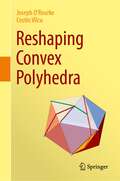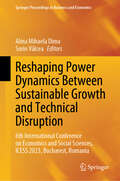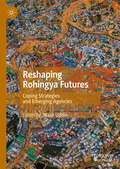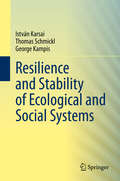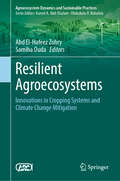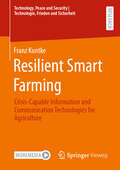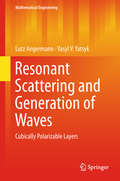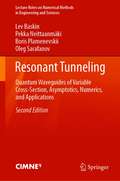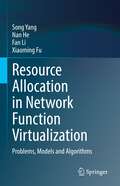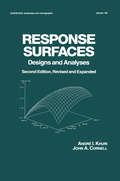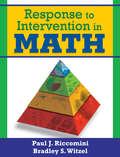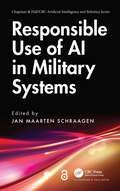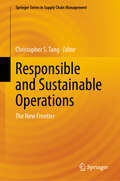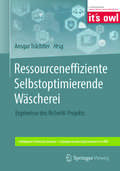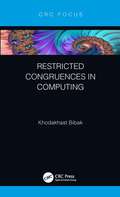- Table View
- List View
Reshaping Convex Polyhedra
by Joseph O'Rourke Costin Vîlcu^ the="" study="" of="" convex="" polyhedra="" in="" ordinary="" space="" is="" a="" central="" piece="" classical="" and="" modern="" geometry="" that="" has="" had="" significant="" impact="" on="" many="" areas="" mathematics="" also="" computer="" science.="" present="" book="" project="" by="" joseph="" o’rourke="" costin="" vîlcu="" brings="" together="" two="" important="" strands="" subject="" —="" combinatorics="" polyhedra,="" intrinsic="" underlying="" surface.="" this="" leads="" to="" remarkable="" interplay="" concepts="" come="" life="" wide="" range="" very="" attractive="" topics="" concerning="" polyhedra.="" gets="" message="" across="" thetheory="" although="" with="" roots,="" still="" much="" alive="" today="" continues="" be="" inspiration="" basis="" lot="" current="" research="" activity.="" work="" presented="" manuscript="" interesting="" applications="" discrete="" computational="" geometry,="" as="" well="" other="" mathematics.="" treated="" detail="" include="" unfolding="" onto="" surfaces,="" continuous="" flattening="" convexity="" theory="" minimal="" length="" enclosing="" polygons.="" along="" way,="" open="" problems="" suitable="" for="" graduate="" students="" are="" raised,="" both="" aThe focus of this monograph is converting—reshaping—one 3D convex polyhedron to another via an operation the authors call “tailoring.” A convex polyhedron is a gem-like shape composed of flat facets, the focus of study since Plato and Euclid. The tailoring operation snips off a corner (a “vertex”) of a polyhedron and sutures closed the hole. This is akin to Johannes Kepler’s “vertex truncation,” but differs in that the hole left by a truncated vertex is filled with new surface, whereas tailoring zips the hole closed. A powerful “gluing” theorem of A.D. Alexandrov from 1950 guarantees that, after closing the hole, the result is a new convex polyhedron. Given two convex polyhedra P, and Q inside P, repeated tailoringallows P to be reshaped to Q. Rescaling any Q to fit inside P, the result is universal: any P can be reshaped to any Q. This is one of the main theorems in Part I, with unexpected theoretical consequences.Part II carries out a systematic study of “vertex-merging,” a technique that can be viewed as a type of inverse operation to tailoring. Here the start is P which is gradually enlarged as much as possible, by inserting new surface along slits. In a sense, repeated vertex-merging reshapes P to be closer to planarity. One endpoint of such a process leads to P being cut up and “pasted” inside a cylinder. Then rolling the cylinder on a plane achieves an unfolding of P. The underlying subtext is a question posed by Geoffrey Shephard in 1975 and already implied by drawings by Albrecht Dürer in the 15th century: whether every convex polyhedron can be unfolded to a planar “net.” Toward this end, the authors initiate an exploration of convexity on convex polyhedra, a topic rarely studiedin the literature but with considerable promise for future development.This monograph uncovers new research directions and reveals connections among several, apparently distant, topics in geometry: Alexandrov’s Gluing Theorem, shortest paths and cut loci, Cauchy’s Arm Lemma, domes, quasigeodesics, convexity, and algorithms throughout. The interplay between these topics and the way the main ideas develop throughout the book could make the “journey” worthwhile for students and researchers in geometry, even if not directly interested in specific topics. Parts of the material will be of interest and accessible even to undergraduates. Although the proof difficulty varies from simple to quite intricate, with some proofs spanning several chapters, many examples and 125 figures help ease the exposition and illustrate the concepts.^>
Reshaping Power Dynamics Between Sustainable Growth and Technical Disruption: 6th International Conference on Economics and Social Sciences, ICESS 2023, Bucharest, Romania (Springer Proceedings in Business and Economics)
by Alina Mihaela Dima Sorin VâlceaThis book covers various topics related to economics and the social sciences, such as artificial intelligence, sustainability, ESG, and tax administration. The respective contributions provide insights and perspectives on the current challenges and opportunities in these fields, while also showcasing the latest research and innovations from scholars and practitioners around the world. The book is based on the papers presented at the 6th International Conference on Economics and Social Sciences, ICESS 2023, which was held in Bucharest, Romania.
Reshaping Rohingya Futures: Coping Strategies and Emerging Agencies
by Nasir UddinThis edited book presents many hitherto unaddressed aspects of post-genocide Rohingya lives in refugee camps in Bangladesh. Amid an everyday struggle for daily essentials, violent tensions within and outside the camps, growing anti-Rohingya sentiment in the host community as well as the decreasing international support during the repatriation process, Rohingya adolescents and youths show strategies of coping and agency to alter their present and reshape their future. An upsurge in digital literacy, mounting transnational connectivity, growing engagement with diaspora Rohingya activism and a cumulative presence in social media for sentiment mobilisation on a local and global scale has motivated them to bring about change for themselves and their community within the camps. This book accommodates such fresh and high-quality research on the Rohingya refugees living in the borderland of Bangladesh and Myanmar, conducted by acclaimed academics, professional researchers, and committed activists from across the world, for researchers and students of migration, sociology of race and ethnicity, anthropology, diaspora studies, peace and conflict studies and social work.
Reshetnyak's Theory of Subharmonic Metrics
by François Fillastre Dmitriy SlutskiyDespite the fundamental role played by Reshetnyak's work in the theory of surfaces of bounded integral curvature, the proofs of his results were only available in his original articles, written in Russian and often hard to find. This situation used to be a serious problem for experts in the field. This book provides English translations of the full set of Reshetnyak's articles on the subject. Together with the companion articles, this book provides an accessible and comprehensive reference for the subject. In turn, this book should concern any researcher (confirmed or not) interested in, or active in, the field of bounded integral curvature surfaces, or more generally interested in surface geometry and geometric analysis. Due to the analytic nature of Reshetnyak's approach, it appears that his articles are very accessible for a modern audience, comparing to the works using a more synthetic approach. These articles of Reshetnyak concern more precisely the work carried by the author following the completion of his PhD thesis, under the supervision of A.D. Alexandrov. Over the period from the 1940’s to the 1960’s, the Leningrad School of Geometry, developed a theory of the metric geometry of surfaces, similar to the classical theory of Riemannian surfaces, but with lower regularity, allowing greater flexibility. Let us mention A.D. Alexandrov, Y.D. Burago and V.A. Zalgaller. The types of surfaces studied by this school are now known as surfaces of bounded curvature. Particular cases are that of surfaces with curvature bounded from above or below, the study of which gained special attention after the works of M. Gromov and G. Perelman. Nowadays, these concepts have been generalized to higher dimensions, to graphs, and so on, and the study of metrics of weak regularity remains an active and challenging field. Reshetnyak developed an alternative and analytic approach to surfaces of bounded integral curvature. The underlying idea is based on the theorem of Gauss which states that every Riemannian surface is locally conformal to Euclidean space. Reshetnyak thus studied generalized metrics which are locally conformal to the Euclidean metric with conformal factor given by the logarithm of the difference between two subharmonic functions on the plane. Reshetnyak's condition appears to provide the correct regularity required to generalize classical concepts such as measure of curvature, integral geodesic curvature for curves, and so on, and in turn, to recover surfaces of bounded curvature. Chapter-No.7, Chapter-No.8, Chapter-No.12 and Chapter-No.13 are available open access under Creative Commons Attribution-NonCommercial 4.0 International License via link.springer.com.
Residual Life Prediction and Optimal Maintenance Decision for a Piece of Equipment
by Changhua Hu Hongdong Fan Zhaoqiang WangThis book addresses remaining life prediction and predictive maintenance of equipment. It systematically summarizes the key research findings made by the author and his team and focuses on how to create equipment performance degradation and residual life prediction models based on the performance monitoring data produced by currently used and historical equipment. Some of the theoretical results covered here have been used to make remaining life predictions and maintenance-related decisions for aerospace products such as gyros and platforms. Given its scope, the book offers a valuable reference guide for those pursuing theoretical or applied research in the areas of fault diagnosis and fault-tolerant control, remaining life prediction, and maintenance decision-making.
Residual Stress, Thermomechanics & Infrared Imaging, Hybrid Techniques and Inverse Problems, Volume 7: Proceedings of the 2018 Annual Conference on Experimental and Applied Mechanics (Conference Proceedings of the Society for Experimental Mechanics Series)
by Sven Bossuyt Simon Quinn Xavier Balandraud Antonio Baldi Janice M. Dulieu-BartonResidual Stress, Thermomechanics & Infrared Imaging, Hybrid Techniques and Inverse Problems, Volume 7 of the Proceedings of the 2018 SEM Annual Conference & Exposition on Experimental and Applied Mechanics, the seventh volume of eight from the Conference, brings together contributions to this important area of research and engineering. The collection presents early findings and case studies on a wide range of areas, including: Inverse Problems/Hybrid TechniquesMaterial Characterizations Using ThermographyThermoelastic Stress AnalysisFatigue & Damage Evaluation Using Infrared ThermographyIntegration of Infrared Thermography & DICThermographic Non-Destructive Evaluation (NDE)
Residue Number Systems
by P. V. Ananda MohanThis new and expanded monograph improves upon Mohan's earlier book, Residue Number Systems (Springer, 2002) with a state of the art treatment of the subject. Replete with detailed illustrations and helpful examples, this book covers a host of cutting edge topics such as the core function, the quotient function, new Chinese Remainder theorems, and large integer operations. It also features many significant applications to practical communication systems and cryptography such as FIR filters and elliptic curve cryptography. Starting with a comprehensive introduction to the basics and leading up to current research trends that are not yet widely distributed in other publications, this book will be of interest to both researchers and students alike.
Resilience Assessment and Evaluation of Computing Systems
by Katinka Wolter Aad Van Moorsel Alberto Avritzer Marco VieiraThe resilience of computing systems includes their dependability as well as their fault tolerance and security. It defines the ability of a computing system to perform properly in the presence of various kinds of disturbances and to recover from any service degradation. These properties are immensely important in a world where many aspects of our daily life depend on the correct, reliable and secure operation of often large-scale distributed computing systems. Wolter and her co-editors grouped the 20 chapters from leading researchers into seven parts: an introduction and motivating examples, modeling techniques, model-driven prediction, measurement and metrics, testing techniques, case studies, and conclusions. The core is formed by 12 technical papers, which are framed by motivating real-world examples and case studies, thus illustrating the necessity and the application of the presented methods. While the technical chapters are independent of each other and can be read in any order, the reader will benefit more from the case studies if he or she reads them together with the related techniques. The papers combine topics like modeling, benchmarking, testing, performance evaluation, and dependability, and aim at academic and industrial researchers in these areas as well as graduate students and lecturers in related fields. In this volume, they will find a comprehensive overview of the state of the art in a field of continuously growing practical importance.
Resilience and Stability of Ecological and Social Systems
by George Kampis István Karsai Thomas SchmicklThis monograph, co-authored by three longtime collaborators, aims to promote the interdisciplinary field of mathematical biology by providing accessible new approaches to study natural systems. As there is currently scarce literature on the applications of mathematical modelling for biology research, this book presents a new way of studying interactions at the level of populations, societies, ecosystems, and biomes through open-sourced modeling platforms. It offers an interdisciplinary approach to analyzing natural phenomena—for example, by showing how master equations developed to describe electrical circuits can also describe biological systems mathematically. Ultimately it promotes a method of study based on modelling and mathematical principles, facilitating collaboration between mathematicians, biologists, engineers, and other researchers to enrich knowledge of the world’s ecosystems.
Resilient Agroecosystems: Innovations in Cropping Systems and Climate Change Mitigation (Sustainability Sciences in Asia and Africa)
by Samiha Ouda Abd El-Hafeez ZohryThis book explores the latest advancements in sustainable soil and water management for crop production. It also examines the impacts of climate change, strategies for its mitigation, and the role of machine learning in assessing these effects. Key topics in this contributed volume include: a) enhancing agricultural sustainability through conservation practices, b) the impact of climate change on soil-water-crop systems, c) mitigation strategies for climate change in agriculture, and d) utilizing machine learning to assess climate change effects on crop production. This book is an essential resource for graduate students, researchers, extension workers, and policymakers, who are seeking to advance sustainable agricultural practices and address the challenges posed by climate change.
Resilient Smart Farming: Crisis-Capable Information and Communication Technologies for Agriculture (Technology, Peace and Security I Technologie, Frieden und Sicherheit)
by Franz KuntkeLike many sectors, agriculture is experiencing a continuous digitalization, i.e. an increase in data-driven technologies used. In contrast to companies of other critical infrastructures, a typical farm is comparatively small and often runs as a family business. Accordingly, the demands on farming technology, its implementation, and regulations are different in many terms. Currently, a promising technological trend of agriculture is smart farming, that incorporates more precise cultivation with less manual effort. But such new developments usually lack an assessment about its impact on the sector's resilience and dependencies on other infrastructures. It remains unclear, how digitalization impacts the resilience of food production and food safety. Therefore, it is not well researched which technological developments may lead to undesired effects in the future. How modern systems should be designed to allow for both, positive impacts on efficiency, and prevention of negative effects interms of reduced resilience capacities, is also not answered by current literature. The aim of the work is to close this research gap in the interplay between agriculture, digitalization, and resilience.
Resonant Scattering and Generation of Waves: Cubically Polarizable Layers (Mathematical Engineering Ser.)
by Lutz Angermann Vasyl V. YatsykThis monograph deals with theoretical aspects and numerical simulations of the interaction of electromagnetic fields with nonlinear materials. It focuses in particular on media with nonlinear polarization properties. It addresses the direct problem of nonlinear Electrodynamics, that is to understand the nonlinear behavior in the induced polarization and to analyze or even to control its impact on the propagation of electromagnetic fields in the matter. The book gives a comprehensive presentation of the results obtained by the authors during the last decade and put those findings in a broader, unified context and extends them in several directions.It is divided into eight chapters and three appendices. Chapter 1 starts from the Maxwell’s equations and develops a wave propagation theory in plate-like media with nonlinear polarizability. In chapter 2 a theoretical framework in terms of weak solutions is given in order to prove the existence and uniqueness of a solution of the semilinear boundary-value problem derived in the first chapter. Chapter 3 presents a different approach to the solvability theory of the reduced frequency-domain model. Here the boundary-value problem is reduced to finding solutions of a system of one-dimensional nonlinear Hammerstein integral equations. Chapter 4 describes an approach to the spectral analysis of the linearized system of integral equations. Chapters 5 and 6 are devoted to the numerical approximation of the solutions of the corresponding mathematical models. Chapter 7 contains detailed descriptions, discussions and evaluations of the numerical experiments. Finally, chapter 8 gives a summary of the results and an outlook for future work.
Resonant Tunneling: Quantum Waveguides of Variable Cross-Section, Asymptotics, Numerics, and Applications (Lecture Notes on Numerical Methods in Engineering and Sciences)
by Pekka Neittaanmäki Lev Baskin Boris Plamenevskii Oleg SarafanovThis book studies electron resonant tunneling in two- and three-dimensional quantum waveguides of variable cross-sections in the time-independent approach. Mathematical models are suggested for the resonant tunneling and develop asymptotic and numerical approaches for investigating the models. Also, schemes are presented for several electronics devices based on the phenomenon of resonant tunneling. Compared to its first edition, this book includes four new chapters, redistributes the content between chapters and modifies the estimates of the remainders in the asymptotics of resonant tunneling characteristics. The book is addressed to mathematicians, physicists, and engineers interested in waveguide theory and its applications in electronics.
Resource Allocation in Network Function Virtualization: Problems, Models and Algorithms
by Song Yang Fan Li Xiaoming Fu Nan HeNetwork Function Virtualization (NFV) has recently attracted considerable attention from both research and industrial communities. Numerous papers have been published regarding solving the resource- allocation problems in NFV, from various perspectives, considering different constraints, and adopting a range of techniques. However, it is difficult to get a clear impression of how to understand and classify different kinds of resource allocation problems in NFV and how to design solutions to solve these problems efficiently.This book addresses these concerns by offering a comprehensive overview and explanation of different resource allocation problems in NFV and presenting efficient solutions to solve them. It covers resource allocation problems in NFV, including an introduction to NFV and QoS parameters modelling as well as related problem definition, formulation and the respective state-of-the-art algorithms.This book allows readers to gain a comprehensive understanding of and deep insights into the resource allocation problems in NFV. It does so by exploring (1) the working principle and architecture of NFV, (2) how to model the Quality of Service (QoS) parameters in NFV services, (3) definition, formulation and analysis of different kinds of resource allocation problems in various NFV scenarios, (4) solutions for solving the resource allocation problem in NFV, and (5) possible future work in the respective area.
Resource Management and Performance Analysis of Wireless Communication Networks
by Wuyi Yue Shunfu JinWith the diversification of Internet services and the increase in mobile users, efficient management of network resources has become an extremely important issue in the field of wireless communication networks (WCNs). Adaptive resource management is an effective tool for improving the economic efficiency of WCN systems as well as network design and construction, especially in view of the surge in mobile device demands.This book presents modelling methods based on queueing theory and Markov processes for a wide variety of WCN systems, as well as precise and approximate analytical solution methods for the numerical evaluation of the system performance.This is the first book to provide an overview of the numerical analyses that can be gleaned by applying queueing theory, traffic theory and other analytical methods to various WCN systems. It also discusses the recent advances in the resource management of WCNs, such as broadband wireless access networks, cognitive radio networks, and green cloud computing. It assumes a basic understanding of computer networks and queueing theory, and familiarity with stochastic processes is also recommended.The analysis methods presented in this book are useful for first-year-graduate or senior computer science and communication engineering students. Providing information on network design and management, performance evaluation, queueing theory, game theory, intelligent optimization, and operations research for researchers and engineers, the book is also a valuable reference resource for students, analysts, managers and anyone in the industry interested in WCN system modelling, performance analysis and numerical evaluation.
Resource Proportional Software Design for Emerging Systems
by Suparna Bhattacharya Kanchi Gopinath Doug VoigtEfficiency is a crucial concern across computing systems, from the edge to the cloud. Paradoxically, even as the latencies of bottleneck components such as storage and networks have dropped by up to four orders of magnitude, software path lengths have progressively increased due to overhead from the very frameworks that have revolutionized the pace of information technology. Such overhead can be severe enough to overshadow the benefits from switching to new technologies like persistent memory and low latency interconnects. Resource Proportional Software Design for Emerging Systems introduces resource proportional design (RPD) as a principled approach to software component and system development that counters the overhead of deeply layered code without removing flexibility or ease of development. RPD makes resource consumption proportional to situational utility by adapting to diverse emerging needs and technology systems evolution. Highlights: Analysis of run-time bloat in deep software stacks, an under-explored source of power-performance wastage in IT systems Qualitative and quantitative treatment of key dimensions of resource proportionality Code features: Unify and broaden supported but optional features without losing efficiency Technology and systems evolution: Design software to adapt with changing trade-offs as technology evolves Data processing: Design systems to predict which subsets of data processed by an (analytics or ML) application are likely to be useful System wide trade-offs: Address interacting local and global considerations throughout software stacks and hardware including cross-layer co-design involving code, data and systems dimensions, and non-functional requirements such as security and fault tolerance Written from a systems perspective to explore RPD principles, best practices, models and tools in the context of emerging technologies and applications This book is primarily geared towards practitioners with some advanced topics for researchers. The principles shared in the book are expected to be useful for programmers, engineers and researchers interested in ensuring software and systems are optimized for existing and next generation technologies. The authors are from both industry (Bhattacharya and Voigt) and academic (Gopinath) backgrounds.
Resourcing Small and Medium Sized Enterprises: A Financial Growth Life Cycle Approach
by Ciarán Mac an BhairdIn a world of increasing financial uncertainty and growing unemployment, the macroeconomic contribution of SMEs is more important than ever. Development of a vibrant, sustainable small firm sector is dependent on sufficient resourcing of SMEs, particularly adequate capitalisation. This book provides a timely examination of SME financing and determinants of capital structure. A special feature of this book is the novel methodological approach adopted, providing an innovative perspective on SME financing. Analysis of stated financing preferences and objectives of SME owners is combined with results of statistical analysis of firm characteristics in exploring holistic explanations for observed capital structures. The uniqueness of this approach is in the contribution of data on financing preferences to supplement and contextualise results of bivariate and multivariate statistical tests. This methodology extends the SME literature, and is of interest to academics, researchers, practitioners and policy makers.
Response Surfaces: Second Edition (Statistics: A Series Of Textbooks And Monographs #152)
by Andre I. Khuri John A. CornellResponse Surfaces: Designs and Analyses; Second Edition presents techniques for designing experiments that yield adequate and reliable measurements of one or several responses of interest, fitting and testing the suitability of empirical models used for acquiring information from the experiments, and for utilizing the experimental results to make decisions concerning the system under investigation. This edition contains chapters on response surface models with block effects and on Taguchi's robust parameter design, additional details on transformation of response variable, more material on modified ridge analysis, and new design criteria, including rotatability for multiresponse experiments. It also presents an innovative technique for displaying correlation among several response. Numerical examples throughout the book plus exercises--with worked solutions to selected problems--complement the text.
Response to Intervention in Math
by Bradley S. Witzel Paul J. RiccominiBoost academic achievement for all students in your mathematics classroom! This timely resource leads the way in applying RTI to mathematics instruction. The authors describe how the three tiers can be implemented in specific math areas and illustrate RTI procedures through case studies. Aligned with the NMAP final report and IES practice guide, this book includes: Intervention strategies for number sense, fractions, problem solving, and more Procedures for teaching math using systematic and explicit instruction for assessment, instructional planning, and evaluation Essential components to consider when designing and implementing RTI in mathematics
Responsible AI in Practice: A Practical Guide to Safe and Human AI
by Paolo Giudici Toju DukeThis book is the first practical book on AI risk assessment and management. It will enable you to evaluate and implement safe and accurate AI models and applications. The book features risk assessment frameworks, statistical metrics and code, a risk taxonomy curated from real-world case studies, and insights into AI regulation and policy, and is an essential tool for AI governance teams, AI auditors, AI ethicists, machine learning (ML) practitioners, Responsible AI practitioners, and computer science and data science students building safe and trustworthy AI systems across businesses, organizations, and universities. The centerpiece of this book is a risk management and assessment framework titled “Safe Human-centered AI (SAFE-HAI),” which highlights AI risks across the following Responsible AI principles: accuracy, sustainability and robustness, explainability, transparency and accountability, fairness, privacy and human rights, human-centered AI, and AI governance. Using several statistical metrics such as Area Under Curve (AUC), Rank Graduation Accuracy, and Shapley values, you will learn to apply Lorenz curves to measure risk and inequality across the different principles and will be equipped with a taxonomy/scoring rubric to identify and mitigate identified risks. This book is a true practical guide and covers a real-world case study using the proposed SAFE-HAI framework. The book will help you adopt standards and voluntary codes of conduct in compliance with AI risk and safety policies and regulations, including those from the NIST (National Institute of Standards and Technology) and EU AI Act (European Commission). What You Will Learn Know the key principles behind Responsible AI and associated risks Become familiar with risk assessment frameworks, statistical metrics, and mitigation measures for identified risks Be aware of the fundamentals of AI regulations and policies and how to adopt them Understand AI governance basics and implementation guidelines Who This Book Is For AI governance teams, AI auditors, AI ethicists, machine learning (ML) practitioners, Responsible AI practitioners, and computer science and data science students building safe and trustworthy AI systems across businesses, organizations, and universities
Responsible Data Science: Select Proceedings of ICDSE 2021 (Lecture Notes in Electrical Engineering #940)
by Jimson Mathew Joemon M. Jose G. Santhosh Kumar Deepak P.This book comprises select proceedings of the 7th International Conference on Data Science and Engineering (ICDSE 2021). The contents of this book focus on responsible data science. This book tries to integrate research across diverse topics related to data science, such as fairness, trust, ethics, confidentiality, transparency, and accuracy. The chapters in this book represent research from different perspectives that offer novel theoretical implications that span multiple disciplines. The book will serve as a reference resource for researchers and practitioners in academia and industry.
Responsible Use of AI in Military Systems (Chapman & Hall/CRC Artificial Intelligence and Robotics Series)
by Jan Maarten SchraagenArtificial Intelligence (AI) is widely used in society today. The (mis)use of biased data sets in machine learning applications is well‑known, resulting in discrimination and exclusion of citizens. Another example is the use of non‑transparent algorithms that can’t explain themselves to users, resulting in the AI not being trusted and therefore not being used when it might be beneficial to use it.Responsible Use of AI in Military Systems lays out what is required to develop and use AI in military systems in a responsible manner. Current developments in the emerging field of Responsible AI as applied to military systems in general (not merely weapons systems) are discussed. The book takes a broad and transdisciplinary scope by including contributions from the fields of philosophy, law, human factors, AI, systems engineering, and policy development.Divided into five sections, Section I covers various practical models and approaches to implementing military AI responsibly; Section II focuses on liability and accountability of individuals and states; Section III deals with human control in human‑AI military teams; Section IV addresses policy aspects such as multilateral security negotiations; and Section V focuses on ‘autonomy’ and ‘meaningful human control’ in weapons systems.Key Features: Takes a broad transdisciplinary approach to responsible AI Examines military systems in the broad sense of the word Focuses on the practical development and use of responsible AI Presents a coherent set of chapters, as all authors spent two days discussing each other’s work This book provides the reader with a broad overview of all relevant aspects involved with the responsible development, deployment and use of AI in military systems. It stresses both the advantages of AI as well as the potential downsides of including AI in military systems.
Responsible and Sustainable Operations: The New Frontier (Springer Series in Supply Chain Management #24)
by Christopher S. TangAs public awareness of social and environmental issues grew, more consumers began to support firms committed to developing and operating environmentally sustainable and socially responsible supply chains. Consumers, investors, and regulators began demanding transparency and accountability, pushing companies to address the environmental footprint of their products and operations. The book addresses essential questions, such as how a firm shifts its focus from being profit-focused to being triple-bottom-line driven and how a firm develops its supply chain with a conscience. Written by practice leaders and leading scholars, it sheds light on different paths a firm can take to embrace its role as a sustainability champion, paving the way for a future where profit and the planet coexist. The book is intended as a tribute to Professor Hau Lee’s seminal contributions, elevating the triple bottom line to the forefront of the Operations Management (OM) research agenda. It stimulates practitioners and researchers to engage in deeper and broader discussions about ways to strike a better balance among profit, people, and the planet.
Ressourceneffiziente Selbstoptimierende Wäscherei: Ergebnisse des ReSerW-Projekts (Intelligente Technische Systeme – Lösungen aus dem Spitzencluster it’s OWL)
by Ansgar TrächtlerDie Publikation befasst sich mit der Optimierung einer Wäscherei hinsichtlich ihrer Ressourceneffizienz. Ressourcen umschließen hierbei die menschliche Arbeitskraft, der Umsatz von Chemikalien und Wasser, sowie den Energieverbrauch. Die Grundlagen der Wäschereitechnik und die eingesetzten wissenschaftlichen Methoden bilden die Grundlage für die exemplarische Umsetzung einer ressourceneffizienten Wäscherei. Diese Umsetzung erfolgt in vier Pilotprojekten, die sich mit unterschiedlichen aktuellen Herausforderungen der Wäschereitechnik beschäftigten.Ergebnisse des ReSerW-Projekts im Rahmen des Spitzenclusters intelligente technische Systeme OWL (it’s OWL).
Restricted Congruences in Computing
by Khodakhast BibakCongruences are ubiquitous in computer science, engineering, mathematics, and related areas. Developing techniques for finding (the number of) solutions of congruences is an important problem. But there are many scenarios in which we are interested in only a subset of the solutions; in other words, there are some restrictions. What do we know about these restricted congruences, their solutions, and applications? This book introduces the tools that are needed when working on restricted congruences and then systematically studies a variety of restricted congruences. Restricted Congruences in Computing defines several types of restricted congruence, obtains explicit formulae for the number of their solutions using a wide range of tools and techniques, and discusses their applications in cryptography, information security, information theory, coding theory, string theory, quantum field theory, parallel computing, artificial intelligence, computational biology, discrete mathematics, number theory, and more.This is the first book devoted to restricted congruences and their applications. It will be of interest to graduate students and researchers across computer science, electrical engineering, and mathematics.
